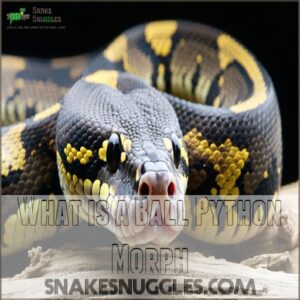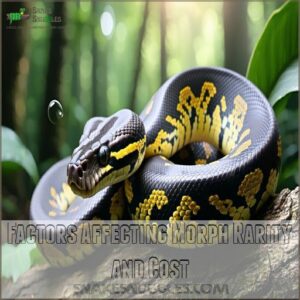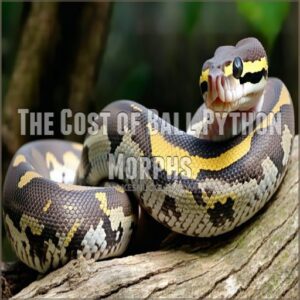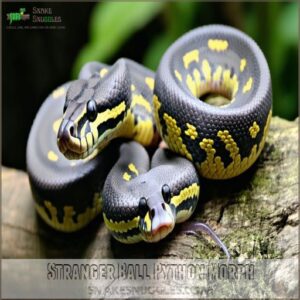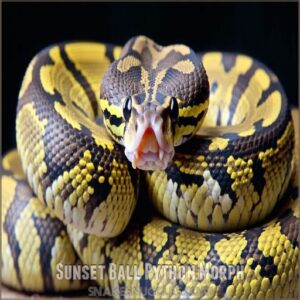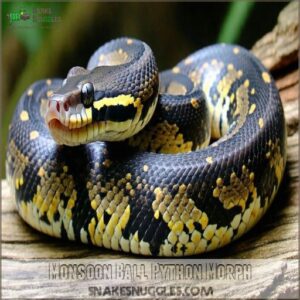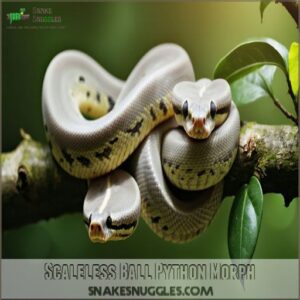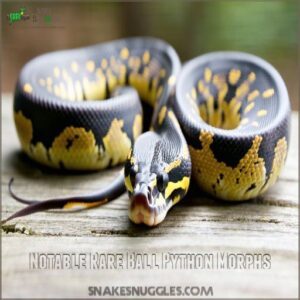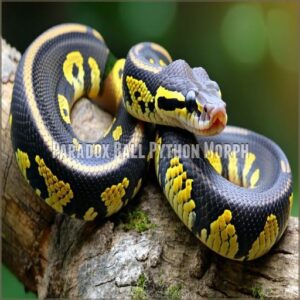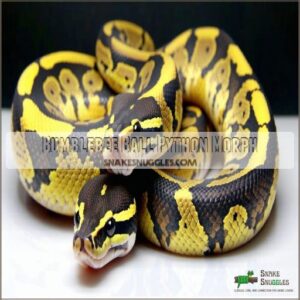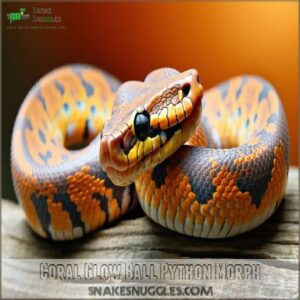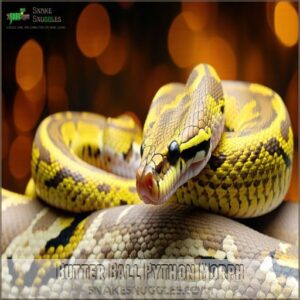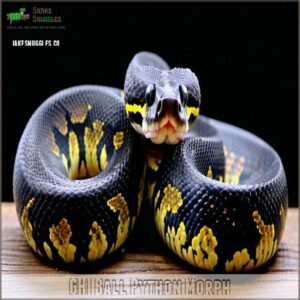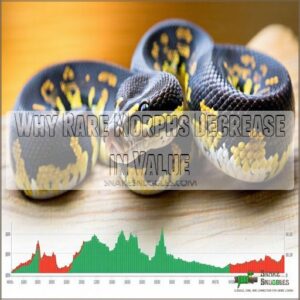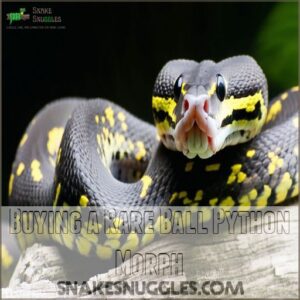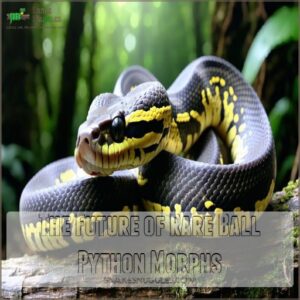This site is supported by our readers. We may earn a commission, at no cost to you, if you purchase through links.
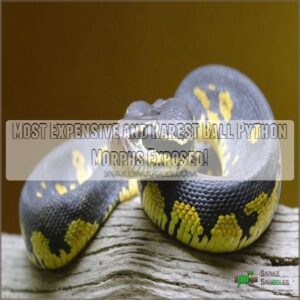 You’ll find the most expensive and rarest ball python morphs commanding prices from $2,000 to a jaw-dropping $30,000.
You’ll find the most expensive and rarest ball python morphs commanding prices from $2,000 to a jaw-dropping $30,000.
The Stranger morph, with its mesmerizing patterns, and the Sunset morph, showcasing rich, deep hues, top the list of coveted specimens.
These genetic masterpieces are rare due to complex breeding challenges and recessive genes – think of them as nature’s limited editions.
The Scaleless morph, lacking most scales except around its eyes, and the uniquely mismatched Paradox morph also fetch premium prices.
Just remember, today’s unicorn morph might become tomorrow’s common snake as successful breeding programs expand availability.
Table Of Contents
- Key Takeaways
- What is a Ball Python Morph
- Factors Affecting Morph Rarity and Cost
- The Cost of Ball Python Morphs
- Rarest and Most Expensive Ball Python Morphs
- Notable Rare Ball Python Morphs
- Paradox Ball Python Morph
- The 12 Rarest Ball Python Morphs
- Why Rare Morphs Decrease in Value
- Buying a Rare Ball Python Morph
- The Future of Rare Ball Python Morphs
- Frequently Asked Questions (FAQs)
- Are ball pythons considered rare?
- Are ball pythons generally expensive?
- Is a specific ball python morph rare?
- How much does a ball python morph cost?
- How much does a Stranger Ball Python cost?
- How many morphs does a Ball Python have?
- What is the most sought after ball python morph?
- What is the rarest snake color?
- What is a rare python snake?
- What ball python morphs to avoid?
- Conclusion
Key Takeaways
- You’ll find the Stranger morph ($7,800) and Sunset morph ($20,000) among the most expensive ball pythons, with Paradox morphs reaching up to $30,000 due to their unique genetic traits.
- You can expect rare morph prices to decrease over time as successful breeding programs increase availability, like the Lavender Albino that dropped from $40,000 to $250.
- You’ll need to understand that ball python morphs result from genetic variations affecting colors, patterns, or anatomy, with over 6,500 documented variations currently available.
- You should avoid Spider, Enigma, and Champagne morphs despite their appeal, as they’re known to develop neurological health issues.
What is a Ball Python Morph
When you hear about ball python morphs, you’re talking about fascinating genetic variations that influence these snakes’ colors, patterns, or anatomy.
These morphs, ranging from subtle to spectacular, aren’t new species but unique variations within the same species, adding an exciting twist to snake breeding and collection.
Genetics Behind Ball Python Morphs
Ball python genetics are fascinating, intertwining morph inheritance, recessive genes, and gene mutations to craft unique patterns.
Morphs arise from rare genes that mix like secret recipes at a genetic café.
Breeders select specific gene combinations, hoping for new discoveries in ball python morphs, making every hatchling a potential masterpiece in rare ball pythons.
How Morphs Affect Appearance
Imagine your pet dressed in unique styles; ball python morphs work similarly, with beautiful changes. They can alter appearance dramatically.
You’ll see:
- Color variations like vibrant yellows or deep blacks.
- Pattern changes featuring stripes or spots.
- Scale mutations, altering the texture.
- Anatomical differences, affecting features like head shape.
These traits showcase python morph genetics, revealing the rarest ball pythons.
Combined Morphs and Unique Patterns
So, you’ve seen how morphs change a snake’s look.
Now, let’s talk about mixing them!
Combined morph genetics create truly unique patterns.
Think of it like mixing paints – you get awesome new colors!
The visual appeal of combined morphs often jacks up the price.
Understanding the genetics behind these morphs, such as dominant, recessive, and co-dominant traits as outlined in this ball python morph guide, is essential for predicting the outcome of combining different morphs.
Here’s a quick peek at some possibilities:
| Morph 1 | Morph 2 | Resulting Pattern | Approximate Price Range |
|---|---|---|---|
| Pastel | Albino | Pastel Albino | $150 – $300 |
| Spider | Clown | Spider Clown | $500 – $1000 |
| Lesser Platinum | Banana | Lesser Platinum Banana | $800 – $2000 |
| Yellow Belly | Mojave | Yellow Belly Mojave | $1000 – $3000 |
Pricing combined morphs depends on rarity and demand, making each one special.
Factors Affecting Morph Rarity and Cost
When you’re exploring what makes ball python morphs both rare and pricey, consider factors like recessive genes and breeding difficulties, which play significant roles.
Add in the excitement of new discoveries, high demand, and unique gene combinations, and you’ll see why some morphs might just require you to save more than your dinner money.
Recessive Genes and Breeding Difficulty
Understanding ball python morphs? Recessive genes are the wild card.
They’re the elusive keys that add a splash of unique rarity to these serpents.
However, the breeding challenge is real, requiring both parents to carry the trait.
This makes ethical breeding essential to produce these gems, ensuring each rare morph shines without compromising on health.
Impact of New Discoveries on Morph Prices
Every new morph discovery shakes up the rare ball python market, introducing fresh trends and shifting prices.
When breeders strike gold with a unique gene, it sparks curiosity and drives up its initial value, often influenced by factors such as genetics, breeder reputation, and morph popularity trends.
Like discovering a hidden gem, a new python morph’s allure can skyrocket prices until breeding success naturally tempers the initial excitement.
Role of Demand in Shaping Morph Costs
Demand plays a big part in shaping ball python morph prices.
When breeders discover new morphs, the excitement skyrockets interest, sending prices through the roof.
Consider sunset morphs—once the talk of the town, they commanded hefty sums.
As more hit the market, costs level off.
It’s like a fashion frenzy, but for snake enthusiasts!
Combined Morphs and Pricing
Regarding ball python morphs, combining genes can skyrocket a snake’s value. Here’s why:
- Visual Appeal: These combinations result in breathtaking patterns and colors, making them highly desirable.
- Breeder Influence: Experienced breeders craft unique morphs, boosting demand.
- Morph Rarity: The rarer the genetic combination, the steeper the price variation.
The Cost of Ball Python Morphs
When you’re shopping for ball python morphs, it’s important to know that prices vary widely based on rarity and demand.
Rare morphs like blue-eyed leucistics can easily cost you upwards of $250.
While you can snag a normal python for under $40.
Price Range for Normal Ball Pythons
So, you’re thinking about adding a normal ball python to your collection?
Great choice!
Expect to pay less than $40 for a healthy one from a reputable breeder.
This is your baseline – normal python pricing.
Factors like age and location can slightly influence the average price, but you’ll generally find deals within this range.
Remember, ethical breeders prioritize the snake’s well-being, not just profit.
Cost of Common Morphs
Common morph prices in ball pythons might surprise you.
Popular morphs like pastels start at around $60, offering a splash of color without breaking the bank.
Although these morphs are less rare than their pricier cousins, they still make striking pets.
Watching morph price trends can be thrilling—like finding a hidden gem at a bargain!
Pricing for Rare and Extreme Morphs
Rare and extreme ball python morphs can put quite a dent in your wallet!
These beauties, like the Stranger and Monsoon morphs, attract high prices due to their rarity and intricate patterns.
For those looking to own or learn more about these unique animals, websites like Chewy Rare Morphs offer a range of products and information.
Here’s a quick list:
- Stranger Morph – about $7,800.
- Sunset Morph – around $20,000.
- Monsoon Morph – starting at $12,000.
- Scaleless Morph – minimum $2,000.
Rarest and Most Expensive Ball Python Morphs
As you explore the realm of ball python morphs, you’ll find that the rarest and most expensive varieties, like the Stranger and Monsoon morphs, are as intriguing as they’re costly.
With prices often soaring due to their unique genetics and intricate patterns, these morphs capture the fascination of breeders and collectors alike, making them a prized addition to any collection.
Stranger Ball Python Morph
Ball python morph prices can soar when you’re looking at rare options like the Stranger ball python morph.
It’s a hot topic in ball python morph market circles, known for unique genes and intriguing patterns.
This table shows key traits:
| Trait | Description | Price Range |
|---|---|---|
| Genetics | Dominant | $7,000+ |
| Breeding | Challenging | High |
| Care | Standard | Moderate |
| Availability | Limited | Low |
| Future | Promising | Growing |
Sunset Ball Python Morph
The Sunset ball python morph is a shining star among expensive ball python morphs.
First appearing with its rich, deep hues, this rare ball python morph captivates collectors seeking unique genetic treasures.
Sunset morph breeders work diligently, crafting these exquisite snakes.
With its striking colors and hefty price tag, the Sunset morph truly embodies prestige and rarity in ball python morph history.
Monsoon Ball Python Morph
Imagine the thrill of owning a Monsoon ball python, one of the rarest and priciest morphs around. This morph captivates with its stunning, speckled pattern and complex genetics.
Embrace the joy of:
- Coveted uniqueness: Fewer out there
- Exclusivity: High breeding difficulty
- Fascination: Intricate genetics
- Pride: Owning an expensive morph
Scaleless Ball Python Morph
From the striking Monsoon morph, let’s look at another rare beauty: the scaleless ball python.
These snakes, lacking most scales except around their eyes, command high prices—$2,000 and up!
Scaleless ball python care requires extra attention due to their delicate skin.
Breeding scaleless morphs presents unique challenges, and ethical considerations, along with scaleless morph legality, are important.
Remember, responsible ownership is key when dealing with these rare ball python morphs.
Notable Rare Ball Python Morphs
When you’re exploring notable rare ball python morphs, you’ll encounter some truly fascinating genetic variations and color patterns that make each snake unique.
From the striking Blue-Eyed Leucistic to the vibrant Lavender Albino, these morphs don’t just dazzle with their looks, but also fetch impressive prices thanks to their rarity and distinctive features.
Blue-Eyed Leucistic Ball Python
Moving from pricy morphs, let’s spotlight the Blue-Eyed Leucistic Python—a sought-after spectacle.
It sports pure white scales and striking blue eyes, resembling a piece of living art.
Known for their alluring presence and unique genetics, these rare ball python morphs command attention in the breeding scene.
Expect prices starting around $1,000, highlighting their demand and appealing allure.
Acid Ball Python Morph
The Acid ball python morph, a striking rarity, is a snake that grabs attention with its vibrant yellow coloring and bold black stripes. You’re looking at a stunner!
Get started with acid ball python care with these tips:
- Maintain a warm, humid environment.
- Provide a diet of frozen-thawed rodents.
- Make sure there’s ample space for hiding.
- Monitor for health issues.
- Embrace their unique beauty!
Piebald Ball Python Morph
Known for its striking contrast of normal colors against random white patches, the piebald ball python morph offers a visual treat.
This exotic ball python morph, stemming from unique genetics, commands a price tag of $1,800 or more, reflecting its rarity among ball python morphs.
Curious about the charm? It’s like owning a living abstract painting!
Lavender Albino Ball Python Morph
Picture a lavender albino ball python, a marvel in the world of rare ball python morphs.
Its ethereal colors captivate enthusiasts, yet its breeding challenges require seasoned skills.
Much like the complex genetic interactions that give rise to unique patterns and colors in other morphs, such as the Piebald Ball Python genetics.
Price trends have shifted since its debut at $40,000, highlighting changes in ball python morph values.
When considering this morph, understanding ethical considerations and care requirements is essential for a responsible purchase.
Paradox Ball Python Morph
You’re about to uncover the mystique of the Paradox Ball Python Morph, a truly unique snake with mismatched markings that captivate collectors worldwide.
With prices soaring up to $30,000, these rare beauties are highly sought after due to their unpredictable patterns and rarity.
Characteristics of Paradox Morphs
Ready to discover the secrets of paradox ball pythons?
These aren’t your average snakes; they’re genetic enigmas!
Paradox morphs showcase striking Chimerism, a bizarre quirk where their colors and patterns clash wildly.
It’s like nature’s own artistic mistake, resulting in:
- Mismatched Patterns
- Unexpected Color Variations
- A Genetic Anomaly
These beautiful oddities make them some of the rarest and most intriguing ball pythons around, a true reflection of nature’s creativity.
Pricing for Paradox Ball Pythons
When snagging a Paradox ball python, expect unique pricing due to their unpredictable markings and chimerism—traits that keep you guessing, similar to the genetic tapestry found in the Sunset Pastel Zebra GHI gene.
Small color patches might set you back under $1,000, but larger, more distinct patterns can command prices soaring up to $30,000.
With their rare morph and challenging breeding, it’s no wonder these snakes are valued so high.
Rarity and Demand for Paradox Morphs
In the enigmatic world of paradox ball pythons, rarity and demand create a thriving yet elusive market.
1. Their genetics, often linked to chimerism, means these beauties can’t guarantee consistent offspring.
2. Breeding paradox morphs, as a result, is a gamble, adding intrigue.
You can explore a range of Paradox Morph products at Paradox Morph Products.
As demand intensifies, prices rise, but like capturing lightning in a bottle, true specimens remain rare treasures.
The 12 Rarest Ball Python Morphs
You’re about to discover the most sought-after ball python morphs that can fetch prices up to $30,000 in today’s market.
These rare genetic variations, including the striking Stranger and elusive Monsoon morphs, represent the pinnacle of ball python breeding achievements.
Bumblebee Ball Python Morph
Looking to add some buzz to your collection? The Bumblebee ball python morph combines the stunning pastel and spider genes, creating a vibrant yellow and black pattern that’s truly eye-catching.
As a result of this unique genetic combination, the Bumblebee Ball Python has a co-dominant genetic inheritance, which can be learned more about in Bumblebee Ball Python Genetics.
While not among the priciest morphs, these beauties typically range from $200 to $400.
Their distinctive striped pattern and golden hues make them popular among both novice and experienced collectors.
Coral Glow Ball Python Morph
The radiant Coral Glow ball python morph dazzles collectors with its stunning orange-pink hues.
Here’s what makes this beauty special:
- First bred in 2002 by NERD Reptiles
- Shows dominant inheritance patterns
- Males typically display brighter coloration
- Prices range from $400 to $1,200
You’ll love how their colors intensify with age, making them a fantastic investment for both novice and experienced keepers alike.
Butter Ball Python Morph
Beauty comes in many forms, but the Butter ball python morph stands out with its warm, buttery-yellow hues. You’ll notice subtle caramel undertones that give this morph its distinctive look.
Here’s what makes Butter morphs unique:
| Feature | Description |
|---|---|
| Pattern | Reduced dark pigments |
| Color | Rich yellow-gold |
| Genetics | Co-dominant |
| Value | $200-$400 |
This morph’s popularity stems from its breeding potential and relatively affordable price point.
GHI Ball Python Morph
Mysterious and alluring, GHI ball pythons showcase an intensely dark base color with reduced patterns that’ll make you do a double-take.
You’ll notice their unique genetic traits create stunning visual effects, especially when paired with other morphs.
While they’re not the priciest morphs around, their breeding challenges and distinctive appearance keep them in high demand among collectors who appreciate their subtle yet striking beauty.
Why Rare Morphs Decrease in Value
You’ll notice that even the rarest ball python morphs eventually lose their sky-high price tags as breeders successfully produce more offspring.
Just like the lavender albino that dropped from $40,000 to $250, your prized morph’s value will likely decrease as it becomes more readily available in the market.
Impact of Breeding on Morph Rarity
Every rare ball python morph faces a predictable path to becoming more common through selective breeding.
When breeders successfully produce offspring with desired traits, they’re essentially revealing genetic blueprints that can be replicated.
While maintaining genetic diversity remains important, each successful breeding season increases the morph’s availability.
This natural progression explains why yesterday’s $40,000 lavender albino now costs just $250.
How Demand Affects Morph Pricing
The ball python collectors market moves like a rollercoaster, with demand driving prices up and down.
When a new morph hits the scene, everyone wants a piece of the action, pushing prices through the roof.
But here’s the catch: as breeders produce more of these snakes and they become readily available, those sky-high prices start tumbling down like dominoes.
This is why some enthusiasts turn to websites that sell products related to ball python morph value.
Role of Time in Shaping Morph Value
Time relentlessly shapes the value of rare ball python morphs, much like waves smoothing rough stones.
You’ll notice that as breeders successfully reproduce these unique specimens, what was once scarce becomes increasingly available.
Just look at lavender albinos – they’ve dropped from $40,000 to $250 as more entered the market.
It’s a natural cycle where exclusivity gradually gives way to accessibility.
Buying a Rare Ball Python Morph
You’ll need to invest both time and money when searching for that perfect rare ball python morph, as these unique serpents can cost anywhere from $1,000 to over $30,000.
Before you make such a significant purchase, you’ll want to research reputable breeders, understand morph genetics, and learn about current market prices to make sure you’re getting the best value for your investment.
Researching Reputable Breeders
Finding a trustworthy breeder starts with checking their reputation online and asking fellow snake enthusiasts for recommendations.
Look for breeders with transparent breeding practices, detailed health records, and a solid track record of producing healthy morphs.
Don’t hesitate to ask about their experience, breeding facilities, and aftercare support.
Reviews from past customers can offer valuable insights into their reliability and quality of service.
Understanding Morph Genetics and Pricing
Diving into ball python morph genetics feels like cracking a complex code, where each genetic combination affects both appearance and price.
You’ll need to understand how recessive, co-dominant, and dominant genes interact to create unique morphs.
Rarer genetic combinations command higher prices, while more common traits typically sell for less, following market demand and breeding success rates.
Tips for Purchasing a Rare Morph
Your rare ball python’s investment deserves careful consideration.
Start by researching reputable breeders with proven track records and documented genetics.
Don’t shy away from price negotiations, but always prioritize quality over cost savings.
Before finalizing any purchase, request detailed health records and verify the morph’s authenticity through genetic testing.
Remember, legitimate breeders welcome questions and provide transparent documentation of their breeding lines.
The Future of Rare Ball Python Morphs
You’ll witness groundbreaking developments in ball python breeding as breeders continue to discover new genetic combinations and morphs in 2025.
Thanks to advanced breeding techniques and growing market demand, you can expect to see even more stunning variations emerge, though they’ll command premium prices until they become more established in the breeding community.
Emerging Trends in Ball Python Breeding
After securing your rare morph, you’ll want to stay ahead of breeding trends.
The ball python community’s pushing boundaries with ethical practices and groundbreaking genetic discoveries.
Here’s what’s shaping the future:
- Advanced genetic testing for healthier offspring
- Collaborative breeding programs across continents
- Digital tracking systems for morph authenticity
- Sustainable breeding practices focused on quality over quantity
The emphasis now lies on responsible breeding, enhancing both snake welfare and market value.
New Morphs and Their Potential Impact
Fresh discoveries in ball python morphs are reshaping the breeding landscape.
While stranger and monsoon morphs currently command top dollar, emerging genetic combinations promise even more striking variations.
Breeders are pushing boundaries with innovative techniques, though ethical considerations remain paramount.
The race for new morphs continues to drive prices skyward, making early adoption essential for serious collectors aiming to stay ahead of market trends.
Evolving Demand for Rare Ball Pythons
While the ball python market continues to evolve, demand for rare morphs shows no signs of slowing down.
Today’s collector community increasingly values ethical breeding practices alongside unique genetics.
You’ll notice a growing emphasis on sustainable breeding programs and conservation efforts, marking a shift from pure aesthetics to responsible ownership.
Looking ahead, expect morph prices to reflect both rarity and ethical considerations.
Frequently Asked Questions (FAQs)
Are ball pythons considered rare?
Regular ball pythons aren’t rare at all – they’re actually one of the most popular pet snakes you can find.
However, certain morphs (special color patterns) can be extremely rare and valuable.
Are ball pythons generally expensive?
Like finding a needle in a haystack, ball pythons aren’t typically expensive pets.
You can get a normal ball python for under $40, while morphs vary from $60 to thousands based on their rarity.
Is a specific ball python morph rare?
Several ball python morphs are considered rare, including the Stranger (€7,000+), Sunset ($20,000+), and Paradox morphs ($1,000-30,000). The rarity depends on genetics, breeding difficulty, and market demand.
How much does a ball python morph cost?
Ball python morphs vary dramatically in price, from $40 for normal patterns to $30,000 for rare paradox types.
You’ll find common morphs like pastels starting at $60, while specialty varieties like blue-eyed leucistics cost around $
How much does a Stranger Ball Python cost?
A Stranger Ball Python will cost you at least €7,000 ($7,800) due to its exceptional rarity and recent discovery.
You’ll need deep pockets for this sought-after morph, which is among the priciest available.
How many morphs does a Ball Python have?
You’ll be amazed to know there are over 6,500 documented ball python morphs today.
Each morph represents a unique genetic variation affecting color, pattern, or appearance of these fascinating reptiles.
It’s quite extraordinary!
What is the most sought after ball python morph?
Currently, Stranger and Monsoon morphs top the most-wanted list, with prices starting at €7,000 and $12,000 respectively.
They’re highly sought after due to their unique patterns and recent discovery in the breeding community.
What is the rarest snake color?
The lavender albino represents one of nature’s rarest snake colorations, but you’ll find paradox ball pythons even more uncommon, featuring striking mismatched markings that can’t be genetically passed to offspring.
What is a rare python snake?
Like finding a pearl in the ocean, rare python snakes include the stunning blue-eyed leucistic python.
You’ll recognize it by its pristine white scales and mesmerizing azure eyes.
Leucistic pythons sell for around $1,
What ball python morphs to avoid?
Steer clear of spider morphs due to neurological issues that cause wobbling. You’ll also want to avoid enigma morphs and champagne morphs, as they’re known to develop similar health problems.
Conclusion
Whether you’re eyeing the most expensive and rarest ball python morphs or just starting your collection, remember that today’s unicorn might become tomorrow’s common find.
While Stranger and Sunset morphs currently command top dollar, successful breeding programs continually reshape the market.
Your dream morph’s value may fluctuate, but the joy of owning these incredible creatures remains priceless. Focus on choosing a healthy snake that captures your heart, regardless of its current market value or rarity status.

